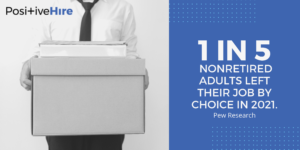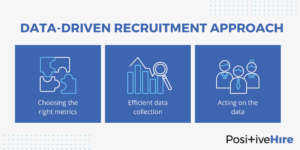Big Data and artificial intelligence have been declared as game-changers for modern HR. Human resource leaders are no longer relying on gut instincts alone to hire, retain, and train talent. They are looking at data, facts, and insights to inform their human resource decisions, talent development, and policies.
This reliance on a data-driven HR approach could not have come at a better time. The job market is chaotic at best at the moment. Even though the companies have started to lay off staff in huge numbers, the wave of Great Resignation that started in early 2021 shows no sign of slowing down. By July 2022, more than 4 million people had resigned from their jobs. But despite all the chaos, U.S. job market witnessesed a record growth of 6.4 million jobs in 2021 and also, unemployment rate went down to 3.9%, according to the Labor Department.

To stop this voluntary turnover and make sure you don’t lose your top talent amidst the chaos, people analytics and artificial intelligence can help.
What is People Analytics?
Traditionally, it has been hard for business decision-makers to quantify the successes and failures of the human resource department. Mainly because it has always been a people-centric area and most of the decisions were based on assumptions, past experiences, and gut-instincts.
People analytics has changed all that. Here is a definition of people analytics by Gartner:
“People analytics is collecting and applying talent data to improve critical talent and business outcomes. People analytics leaders enable HR leaders to develop data-driven insights to inform talent decisions, improve workforce processes and promote a positive employee experience.” – Garter Glossary
But if you are new to it, the sheer scope of people data and analytics can be overwhelming.
People analytics encompasses the person as a whole. Someone studying people analytics maybe looking at work-life balance data, or fairness and transparency practices, or employee physical and emotional wellbeing. It aims to understand people as more than just your employees so you can learn about their motivations, tipping points, and career needs. These analytics are priceless when you use them to create personalized rewards, talent development, better hybrid work policies, and transparent compensation packages.
How Can Data Help In Talent Retention And Development?
Now that we understand the importance of people analytics and what kind of data is available for HR teams to browse through, let’s see how this data can help us design practices that keep people happy at their jobs, for longer.
1. Optimize Recruitment
Hiring an employee is one of the most valuable business investments you can make. Considering it also costs a lot — according to a recent survey from Glassdoor, the average cost per hire is around $4,000 — you want to make sure that you are hiring top quality talent. Someone with the exact skillset you are looking for, with a great attitude, and who is a perfect fit for your company culture.
With a data-driven recruitment approach, you can make it happen. This approach comprises of three steps:

Some common recruitment KPIs to focus on include:
- Cost-per-hire,
- Time-to-hire,
- Source of hire,
- Interview-to-hire ratio, and
- Offer acceptance rate.
When you record and analyze this data, it can help you make critical hiring decisions. For example:
- Identify the source of hiring that’s bringing in the most quality talent and allocate a larger portion of budget to it;
- Spot stages of hire where the most number of candidates seem to fall through and learn how to close that gap; and
- Undertake compensation research to offer salaries and perks that are bound to get your job offers accepted by your ideal candidate.
Optimized recruitment not only helps facilitate HR but also books talent that is likely to stay with the company for a long time, reducing the turnover rate and leading to talent development, too.
2. Offer Attractive Salary and Benefits Packages
Higher pay is consistently one of the top reasons people leave their jobs. While recruiters and businesses know that people are looking for better wages, the ‘better’ remains highly subjective.
Data can help you represent that term with a number.
By researching your industry and market averages, your company finances, and what candidates of a comparable level are getting, you can arrive at a specific pay range. You can then also use that insight into determining other types of financial perks such as:
- Pay raises
- Annual bonuses
- Performance bonuses,
- And more.
You can also use people analytics to divide your workforce into groups based on what company benefits they will find the most valuable and how to manage salaries as per employee contributions. For some, it could be on-site childcare or pet insurance which has become popular during the pandemic. For others, it could be a more flexible work schedule.
By offering them benefits that will make their lives easier and more meaningful,you will establish yourself as a great place to work at. Not only will you become more attractive for high-quality talent but by consistently providing effective benefits, you will keep your workforce loyal to you, too.
Or at least to the competitive benefits you are offering.
3. Improve Employee Experience
To keep your top talent happy with you and performing optimally, it is important to leverage people analytics to help shape your HR and organizational practices. Creating a better work environment, providing a more flexible and fulfilling work-life balance, and giving your employees all the tools they need to do their jobs well, all improve employee experience and contribute to building a better team.
By analyzing key HR metrics, you can spot areas where you need to make the most investments to improve the employee experience. Some of these metrics could be:
- Voluntary turnover
- Absenteeism rate
- Employee productivity
- Performance
- Overtime hours,
- And more.
Reskilling your talent is particularly an important area where intelligent HR can help. You can identify employee groups with the highest potential and provide them with upskilling training that not only enhances their career progression but also diversifies their skillset.
When people know that their companies are investing in them, it leads to a more involved and engaged workforce. One that feels a level of ownership of their work and a certain pride in being associated with such a brand – not to mention, it results in a healthy work culture where upward mobility is rewarded and encouraged.
4. Identify Flight Risks
We have already talked about how costly it can be to hire new people. With attrition rates rising all the time, and the bargaining power now with employees more than the employers, trying to stop people from leaving after they have resigned, maybe too little too late.
Mostly because people have already made up their minds, accepted other job offers, or have more than just the salary as their reason for quitting the job.
With the help of HR predictive tools, you can create flight risk models that alert you to what employee attitudes or performance indicators are a sign that someone may be getting ready to leave.
IBM, which has already replaced 30% of its HR staff with AI models, claims that it can predict with 95% accuracy which employees will leave their jobs. But anonymity is the key here. If you choose to share that data with the management, identifying the employees in the process, it can be a singularly bad idea.
- It can prevent other employees from answering feedback questions truthfully
- It can compromise the quality of your data
- It can also make managers change their attitude toward the identified employees, further worsening the situation.
Therefore, it is critical to ensure that your flight risk models are used only to help you understand how to value your talent more. By learning that you can get through to your employees long before they start looking for other jobs. By addressing their frustrations early on, you can offer solutions that are most likely to entice them to stay, preventing a lot of wasted time, money, and effort.
5. Develop Better DEI Policies
Companies that are getting serious about their diversity, equality, and inclusion policies are increasingly becoming future-proof. Better brand reputation, more profits, higher productivity, and greater talent retention rates are some of the perks that come with making workplaces more diverse and inclusive.
According to a McKinsey report, companies with robust DEI practices continually outperform their rivals in financial returns, better decision-making, employee engagement, and innovation..
Analyzing critical HR data can help your business learn DEI things like:
- Is there a specific employee demographic that’s applying for open positions more than others?
- What does the organizational pay gap look like, from the gender pay gap to CEO-to-worker?
- Do your training programs include people from all employee levels or is there some unintentional bias that needs to be unearthed?
While you can use a wide variety of data for this purpose, some key metrics to include should be:
- Hiring data
- Retention data
- Promotions
- Discrimination complaints
- Turnover rate
- Training programs data,
- And more.
It’s important to note that in many states in the US, DEI policies have ceased to become an HR trend, and are part of the law now. But to create policies customized to your workforce, digging deeper into your data is key. Instead of offering blanket solutions to the entire employee base, talk to your workers with lived experiences to get a nuanced understanding of the matter.
By focusing on education, accountability, and transparency can you create a baseline DEI that can help guide you towards a sustainable roadmap?
6. Establishing Meritocracy
Talented, passionate employees look for recognition and rewards that go beyond pay raises and benefits. I’m not saying your top performers won’t appreciate a surprise bonus, but if you stop there and do not offer them career mobility, you won’t be able to retain them for longer.
The biggest hurdle in rewarding great employee performance, however, lies in unintentional distribution of opportunities that may disadvantage women and other marginalized communities.
How can you create a balance?
- Using data, you can create dynamic job evaluation systems to reward high performers based on skills and specialties.
- Data can also help you create pay policies that are proportionate to the contribution, not tenure.
- Also, career progression paths can be determined through algorithms that take into account individual passion, skillset, training, and contribution.
When creating a meritocracy, people are afraid that DEI goals might be compromised. However, objective use of data analysis can be the key to acquiring and retaining talent from diversity pools. You will be hiring from marginalized groups but you’ll be choosing the top talent from that stream, not just giving the job to anyone. And data can help you remove any bias from that.
Does Data Analytics have a Future?
As we conclude today, the biggest takeaway from the discussion should be the understanding that data, with all its wealth and might, has its limitations. Those who are creating the analytical algorithms may bring a lot of bias into systems that are being designed to keep such biases away.
As you being to incorporate data into your HR practices, it’s important to look deeper and see the intention with which it’s collected, be transparent about its uses with your employees, and run analytics with mindfulness of improving company culture, rewarding good work, optimizing productivity, establishing transparency, and identifying growth potential.
Related Article:

